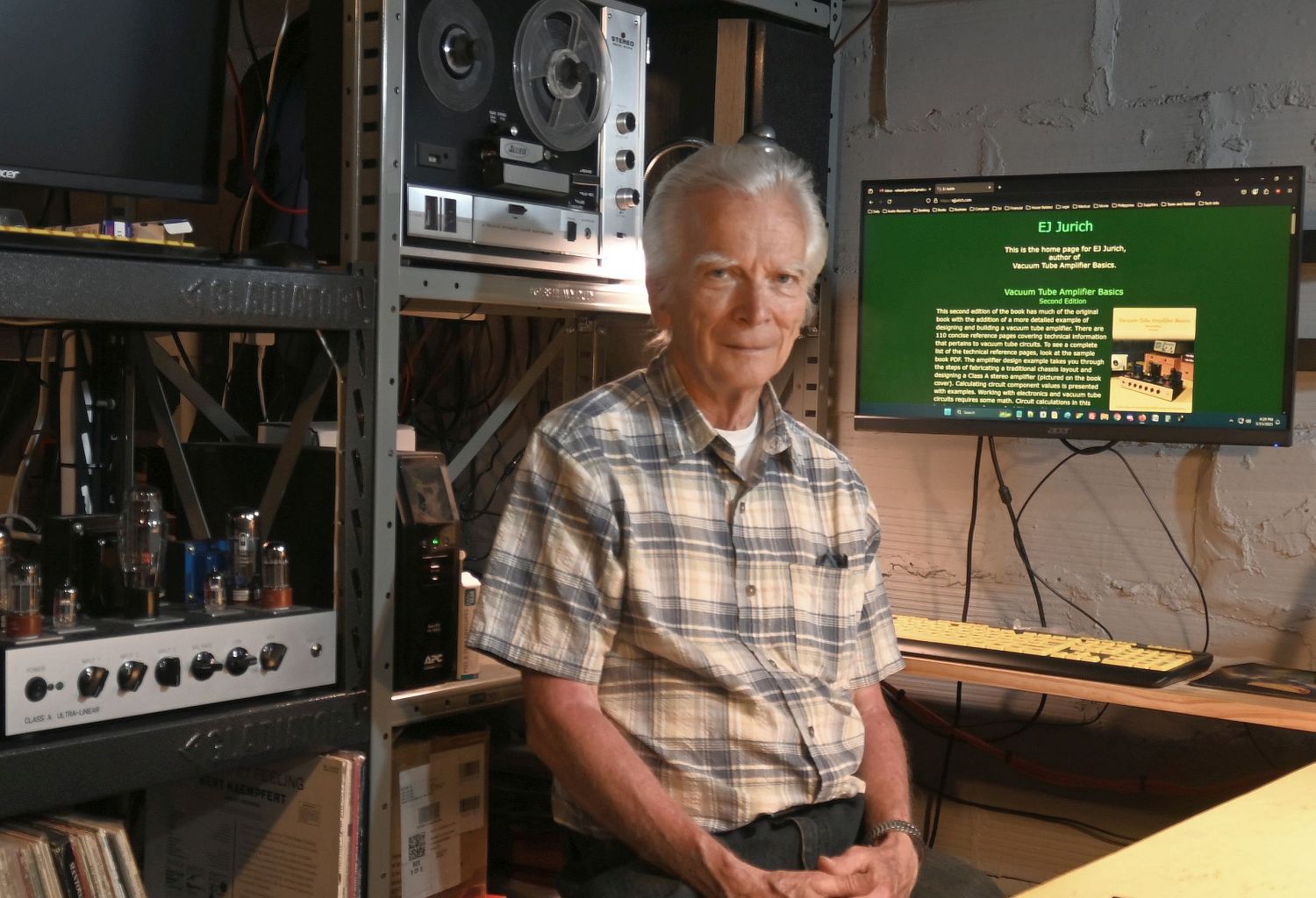

EJ Jurich
author of
Vacuum Tube Amplifier Basics
EJ Jurich
author of
Vacuum Tube Amplifier Basics
Born May 1945
Originally From Chicago
Profession: Radio Broadcast Engineer, retired


Started tinkering with vacuum tube electronics in 1955 at the age of ten. By 1962 I was working with more robust circuits, creating a favorite stereo amplifier using 6CA7 output tubes. Although I had electronic training in the Air Force, by that time I was already beyond that level of education from what I learned at a younger age. I also had an electronics-savvy father that helped me along.
In 1969, I developed an interest in radio broadcast engineering, passed FCC exams, and received an FCC First Class License. The first radio job was as assistant engineer at WROK in Rockford, Illinois. A few months later, I was hired by CBS in Chicago as a staff engineer. Stayed with CBS for three and a half years. In the summer of 1973, WROK was looking for a new chief engineer and offered the position to me. Slightly more than forty years were spent working at various radio stations around the country as chief engineer. This includes Milwaukee, Miami, Mobile, Baltimore, Birmingham, Grand Rapids, St. Louis, and Kansas City. Engineering responsibilities included maintaining studio and transmitter equipment with power levels up to 50 kW AM and 100 kW FM. Back in the early 1970s, some of the studio equipment in use, such as mixing consoles and older reel-to-reel tape machines, was vacuum tube. Transmitters were also vacuum tubes.
After retirement, there was more time to work on tube amplifier designs. In 2014, it was decided to write a book geared towards the electronic hobbyist, Vacuum Tube Amplifier Basics. The original book was sold on Amazon as a Kindle format book. Later, a printed version was also sold on Amazon. The Kindle format was dropped because of flowing text issues. The quality of the printed books was not great: cheap paper and text that looked like faded gray. The print books were discontinued in the summer of 2024 while working on the second edition of the book. Writing books is a lot of work. In my case, besides writing text, a lot of images had to be handmade. I later started running the text through a grammar checker, adding extra work hours. Rather than write books, I will be doing what I like best, tinkering with circuits. If I have something new to show, it will be on this website. Keep in mind that in May of 2025 I turned 80 years old. I am not quite as fast as I used to be. I also have other non-electronic projects going on. Updating the website may be slow at times.
Learning Electronics:
In 1955 there was a much better chance of learning at a young age. Safety rules in effect now enforce such stringent restrictions
that they impede learning at younger ages. For example, the tubes I used in 1955 (at the age of ten) were 35W4 rectifiers, 12AX7,
and 50C5 output tubes. These were mostly tubes used in AC/DC radios of the time. Filaments were wired in series and connected
directly across the 115VAC power mains. The 35W4 rectified AC directly from the 115VAC power mains; there was no power transformer.
This would mean working with a chassis where ground circuits connected directly to the AC power mains. Back then AC plug prongs
were the same size, allowing a plug to be plugged into an AC outlet either way. Depending on which way the amplifier was plugged
into an AC outlet, circuit grounds might actually be on the hot AC mains. The chassis was generally grounded through a capacitor
bridged by a 220K resistor. The 220K resistor was to limit current; the capacitor provided an AC ground path. The point being, I
learned using actual live circuits.
Those early amplifier circuits that did not use power transformers were used in less expensive products such as tabletop radios and record players. As you might imagine, they usually had some low-level hum in the audio. Working with electronics at such an early age does require supervision. In my case, my father was supervising me, although I mostly experimented by myself. If I touched something that gave me a shock, I learned not to touch that. What I learned at an early age sharpened my senses that enabled me later in life to work with transmitter potentials as high as 40,000 volts @ 4 amps (Harris MW-50 AM 50 kW transmitter).
I was always fussy about the sound at stations I was chief engineer. Audio processing was set for a clean sound without the compressed sound of the time. In 1990, while chief engineer at WWMX in Baltimore, I built an all-12AX7 broadband audio processor that used dual time constants. The first time constant was at the processor input and was a very slow averaging level control. The second time constant was after the first and had a faster level control. The first slow level control prevented the second level control from being driven hard. The 'home-built' processor was installed in the station audio chain in the middle of the night without telling anyone. The processor was in front of the Orban processor. Broadband processing in the Orban was turned down, letting the 12AX7 processor do all the broadband control. When put on the air, the on-air audio had a cleaner, fuller, open sound. Although the broadband processor kept audio levels constant, the natural harmonics produced by the 12AX7s provided a sound where loud audio passages sounded louder even though the audio level was being reduced by the processor. In all, the on-air signal sounded louder and cleaner. Something that within a week brought compliments on how good the station sounded.
Photo © 5/2025
Lourdes Jurich
last update 07/11/2025